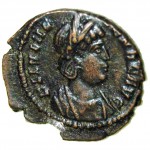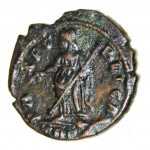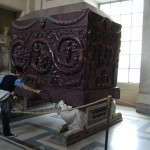Helena, mother of Emperor Constantine the Great
Not so long ago, my collection of artifacts was supplemented with a Roman coin dating back to the 4th century with an image of Saint Helena. We know from history, who Helena was and what contribution this woman made into the spreading of Christianity.
Flavia Julia Helena Augusta (Flavia Iulia Helena, Latin, circa 250—330) — was the mother of Roman Emperor Constantine I. She is famed for her active propagation of Christianity and excavations that she carried out in Jerusalem, during which, according to the assertions of some Christian chroniclers, the Holy Sepulchre, the True Cross and other relics of the Lord’s Passions were gained.
Helena is revered by a number of Christian churches as one of the saints equaled with the Apostles (Holy and Equal to the Apostles, Sovereign Helena, Helena of Constantinople).
The exact year of Helena’s birth is unknown. She was born in a little settlement Drepanum (Latin) in Bithynia, close to Constantinople in Asia Minor, according to Procopius. Later, her son Emperor Constantine the Great in honour of his mother “made the former settlement Drepanum into a city and called it Helenopolis.” Today this settlement is identified with Turkish city Hersek, in the vicinity of Altyn, Yalova province.
As the modern historians believe it, Helena helped her father at a stable station, she poured wine for the travelers, who were waiting while their horses were harnessed and their carriages horsed, or just worked as a waitress at the inn. Probably, it was there where she met Constantius Chlorus, who became the ruler (Caesar) of the West under Maximian Herculius. In the beginning of 270s, she became his spouse, or a concubine, that is, a common-law wife.
On February 27 of 272, in the city of Naissus (today’s Nis in Serbia) Helena gave birth to a son – Flavius Valerius Aurelius Constantine, the future Emperor Constantine the Great, who introduced Christianity as the state religion in the Roman Empire. Whether Helena had any other children is not known.
In 293, Constantius was adopted by Emperor Maximian and broke up with Helena to marry Maximian’s adopted daughter Theodora. Since that time and until the beginning of her son’s reign, there is no information about Helena’s life. Probably, she did not travel far from her native places, since her son, Constantine, started his rise from Nicomedia (in the center of Bithynia), from where he was summoned in 305 to the West by his father, who became the Emperor of the western part of the Roman Empire. It is quite possible that Helena moved to the west to be closer to her son in Treves (modern Trier), which became Constantine’s residence after he inherited from his father the furthermost western part of the Roman Empire. In a brochure, published by the episcopate and clergymen of the Trier Cathedral, it says that saint Helena “gave a part of her palace to bishop Agritius” to be used as a church, thus, becoming the founder of the Trier’s Cathedral of Saint Peter.
When Constantine adopted Christianity (after his victory at the Milvian bridge in 312), Helena also followed his example to turn into Christianity, although by that time she had been already over sixty years old. Concerning this, there is a testimony of Eusebius of Caesarea, who was their contemporary, which survived till our days. The first coins with the image of Helena, where she is entitled Nobilissima Femina (literally, “the noblest woman”), were minted in 318—319 in Thessalonica. At that period, Helena, supposedly, lived at the Emperor’s court in Rome or Trier, but there is no record of that in the ancient chronicles. In Rome she owned a large estate close to the Lateran. In one of the facilities of her palace, a Christian church was made — Helena’s Basilica (Liber Pontificalis claims that it was built by Constantine, but historians believe that it is not altogether unlikely that the idea of rebuilding the palace belonged to Helena herself).
In 324, Helena was proclaimed by her son as Augusta, “he crowned his God-wise mother, Helena, with the crown of the kings and allowed her, as a queen, to mint her own coins.” Eusebius noted that Constantine entrusted Helena with managing the royal treasury at her own discretion. There is also a testimony of the emperor’s high respect for his mother from a non-Christian historian. Aurelius Victor renders a story of how Constantine killed his wife Fausta because of Helena’s reproving her.
In 326, Helena, being quite at an elderly age, although in good health, made a pilgrimage to Jerusalem, “this godly elderly woman of unprecedented wisdom with the agility of a young person hurried to the East.” Eusebius gave a detailed report about her godly actions during the journey, and its distant reminiscences are found in a rabbinic anti-Gospel work of the V century “Toledot Yeshu,” in which Helena (Constantine’s mother) is called the ruler of Jerusalem and associated with the role of Pontius Pilates.
Helena passed away when she turned 80 – according to different calculations, in 328, 329, or in 330 AD. The place of her death is not known for sure, some believe that it was Trier, where she had her palace, or even Palestine. The version of Helena’s death in Palestine is not confirmed by Eusebius Pamphili’s note that she “ended her days in the presence, before the eyes and in the embrace of her great son, who was serving her.”
When she was around 80 years old, Helena made a journey to Jerusalem. Socrates Scholasticus writes that she did it after she was instructed to do so in a dream. “Chronographia of Theophanes” tells us the same, “she had a vision, in which she was ordered to go to Jerusalem and uncover the sacred sites that were closed up by the godless.” After she received her son’s support in this enterprise, Helena set off for the pilgrimage:
«…godly Constantine sent blessed Helena with gifts to seek out the Holy Cross of the Lord. Jerusalem’s patriarch, Macarius, met the Queen with appropriate honour and together with her searched for the desired life-giving tree, continuing in quietness and earnest prayers and fasting.»
(Chronographia of Theophanes, the year of 5817 from creation (324/325AD)
In her search for the Christ Passions’ relics, Helena made excavations on Calvary, where a cave was dug out, in which, according to the tradition, Jesus Christ was buried, and where she gained the True Cross, four nails and the title plate “INRI.” Also, although it is not proven by historic chronicles, with Helena’s pilgrimage the origin of the Holy Ladder is associated. Her discovery of the True Cross set the starting point for celebrating the holiday of the Raising Up of the Holy Cross. In her excavations, Helena was helped by Jerusalem’s bishop Macarius I and a local dweller Judas Kyriakos, mentioned in the apocryphal works.
This story is narrated by many Christian authors of that time: Ambrose of Milan (circa 340—397 AD), Rufinus (345—410 AD), Socrates Scholasticus (circa 380—440 AD), Theodoret of Cyrus (386—457 AD), Sulpicius Severus (circa 363—410 AD), Sozomen (circa 400—450 AD), and others.
Helena’s journey and her benevolence during the pilgrimage are described in the “Life of the Blessed Basileus Constantine” by Eusebius of Caesarea, written after Constantine’s death to glorify the emperor and his family.
As she traveled throughout the east with royal grandeur, Helena generously scattered benefactions both on the general population of the cities and on everyone who would come to her, “her hand generously rewarded the soldiers, helped the poor and the needy a lot. To some she gave money, others she abundantly supplied with clothing to cover their nakedness; she freed some from shackles, delivered them from the hard labour in quarries, redeemed from moneylenders and brought some out from imprisonment.
During her stay in the Holy Land, Helena founded a number of temples on the sites of the Biblical events:
- on Calvary — the Church of the Holy Sepulchre;
- on the Mount of Olives — the Church on the site of the Evangelical Ascension of Christ;
- in Gethsemane — the Church of the Holy Family;
- in Bethlehem — the Basilica of the Nativity of Christ;
- in Hebron — the Chruch near the Oak of Mamre, where God appeared to Abraham;
- in Bethany — the Church over the Lazarus’ Tomb;
- at the Lake of Tiberias — the Church of the Twelve Apostles;
- at the site of Elija’s assumption — a church in the name of this prophet;
- on the Mount Tabor — a temple dedicated to Jesus Christ and Apostles Peter, James and John.
The list of constructions attributed to Helena has a later origin and is contained in her hagiography, written in the VII century. Earlier authorities (Socrates Scholasticus, Eusebius Pamphili) only tell us about Helena’s constructing three churches: one on the Calvary, one in Bethlehem and one on the Mount of Olives.
According to Socrates Scholasticus, Empress Helena divided the True Cross into two parts – she placed one part in a silver container and left it in Jerusalem, “as a memorial for future historians,” and the other one she sent to her son Constantine, who put it into his statue, which is set on a column in the center of Constantine Square. Helena also sent two nails from the Cross to her son (one was built into a diadem, the other one – into a bridle). On the way back from Jerusalem, Helena founded a number of monasteries (for example, Stavrovouni Monastery on Cypres), where she left some particles of the relics that she discovered.
Historians are still arguing about the year of Helena’s activities in Palestine. It is widely accepted that it was in 326 – the date, which is given by Socrates Scholasticus. Socrates does not give the year, when the discovery of the True Cross was made, but in his Church History this event is recorded right after the mentioning of the celebration of the 20th anniversary of Constantine’s reign (25th of July, 326). In the XVIII century, orient scholar Joseph Assemani (Babylon library’s director) believed that the Cross was discovered by Helena on May 3rd of 326 (Julian calendar).
Russian theologian, Professor M. N. Skaballanovich, on the basis of an Alexandrian chronicle of the VI century, dates the discovery of the Cross back to 320. Besides, he absolutely does not agree with dating this event to 326, since, in his opinion, Helena died in the year when the Nicean council was held – that is, in 325.
After Helena’s death, her son moved her body to Rome, concerning which Eusebius Pamphili reports:
«…the body of the blessed lady was also given extraordinary honours. Accompanied by numerous spear-bearers (doryphoros), it was carried into the royal city and there it was laid in the royal shrine. This is how the Basileus’s mother passed away, worthy of everlasting memory both for her godly acts and for the successive and wonderful branch that sprang from her (that is, for Constantine)…»
According to some historic sources, Helena was buried in Rome in a mausoleum on Via Labicana outside the Aurelian walls. The tomb adjoined the church of saints Marcellinus and Peter (both were constructed in the 320s by Emperor Constantine). According to Liber Pontificalis, this tomb was originally built by Constantine for his own burial. For his mother’s burial Constantine not only provided his own vault, but also a porphyritic sarcophagus, which was built for him and is kept now in the museums of Vatican.
Helena’s sacred remains were moved in IX century from the Church of Saints Marcellinus and Peter to an abbey in the town of Hautvillers in Champagne, in the vicinities of Reims (France). They stayed in it till 1871, and during the Paris Commune they were moved to Paris where they are preserved in the church of Saint-Leu-Saint-Gilles.
Helena’s relics, that were remaining in the mausoleum, during the papacy of Innocentius II (1130—1143) were transferred from the church of Marcellinus and Peter to the Church Santa Maria in Aracoeli on the Capitoline Hill. Helena’s sarcophagus was used for the burial of Pope Anastasius IV (1153—1154), for which purpose it was moved from the mausoleum to the Lateran Basilica.
In 1356, Emperor Carl IV presented the reliquary with the head of Saint Helena to the cathedral church of Trier city. There is also one of the nails of the Lord’s Cross kept in the cathedral, which, according to tradition, was discovered by Helena during the excavations in Jerusalem.
According to the Orthodox tradition, two years after Helena’s remains were interned in Rome, they were brought to Constantinople, where the emperor’s shrine was made in the Church of the Apostles.



